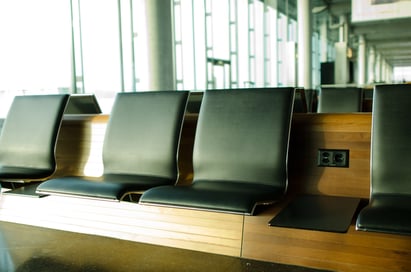10 Ways Low Cost Airlines Can Make More Money
Low-cost airlines have the potential to excel in their markets and become the leading providers in their competitive areas. From the days of People Express Airlines, to the likes of Southwest and Virgin America, successful low cost carriers offer unprecedentedly low prices while maintaining an impressive rate of growth.
With tickets often priced at a third of the cost of competing airlines, low-cost carriers sure manage to attract crowds – but what are successful low-cost carriers doing differently than their unsuccessful low-cost carrier counterparts? What strategies are the CEO’s of these airlines using to generate revenue from their passengers?

10 ways that low-cost airlines can increase their revenue
(even while offering passengers those ridiculously low air fares):
1. Fleet Utilization and Uniformity:
For larger low-cost carriers that offer dozens of flights every hour, revenue can be maximized through fleet utilization and uniformity. Having the same type of airplane in a fleet helps larger low-cost airlines save time and money on training pilots, flight attendants, and technicians. Standardizing practices across the fleet also increases operational efficiency and contributes to optimum performance. These airlines are able to have airplanes flying the majority of the time, with minimal breaks in the schedule for maintenance and other routine checks.
2. Custom Cabin Configuration:
Another tactic low-cost airlines can use to keep costs down is to custom order cabin fittings and accessories to reduce the total weight of the airplane. After all, less weight equals less fuel burned (which equals big savings!)
Some examples of low-cost airline cabin configurations include: removing window shades or installing lightweight seats with no extra frills like TV screens, charging ports, or bulky armrests.
3. Reduced Turnaround Times:
The most successful low-cost airlines are all about maximum efficiency! One of the biggest time and money saving techniques low-cost airlines can deploy is adjusting their internal processes to reduce turnaround time. Turnaround time is the time needed to get all of the passengers off, load and service the airplane for its next flight, and board a new set of passengers for the upcoming journey. Low-cost airlines can deploy several staff members at the same time to drastically reduce turnaround times to around thirty minutes for each flight. This means more time in the air and consequently more profits!
4. Flight Attendants:
Low-cost airlines can save money by scouting out young talent to become their flight attendants. Appointing young and enthusiastic individuals who are at the beginning of their careers, is a great way for airlines to leverage an excellent team (with all the necessary training and superb customer service) without having to fork out top salaries. It is a win-win situation as it provides young flight attendants with the opportunity to log many hours and gain valuable experience working with a fast-paced airline; helping them build their resumes as soon as they have graduated!
5. Direct Sales:
Another important competitive advantage low-cost airlines should leverage is the use of direct sales channels. Low-cost airline passengers generally buy tickets directly from the airline, cutting off any middlemen and thereby reducing overall costs. Thanks to the internet and automation in passenger reservation technology, purchasing a ticket has become a paperless practice, which saves money and counts as an important environmentally conscious business approach.
6. Excellent Customer Service:
Low-cost airlines should take pride in their quick and witty customer service. Some low-effort, high-return customer service activities that low-cost airlines could offer include: giving kids the opportunity to meet the pilot after their flight, sending out coupons for free flights after delays, running social media campaigns for free-tickets (to fill seats that might otherwise be left empty), and attentively responding to passenger needs through Facebook and Twitter.
7. Choosing Smaller Airports:
One of the most important things low-cost airlines can do to keep costs down is to choose smaller airports to fly into (or out of). Every airport charges an airline many fees including: service fees, loading fees, unloading fees, parking fees, and fuel costs (to name a few). Smaller airports generally charge less, and if they are in the same proximity to the major city or destination, it makes a lot of sense for low-cost airlines to choose them.
8. Ancillary Revenue:
Ancillary revenue generation is an important asset for low-cost airlines that can help them improve their profits in the long term. An example of ancillary revenue generation that requires minimum investment is the use of boarding groups instead of assigned seating. There is no doubt that travelers, especially business travelers, would prefer to board the airplane before the rest of the passengers get on. Southwest did a successful run with priority boarding groups called “Business Select” which allowed corporate travelers to get ahead of the remaining passengers. This service can be included against an extra cost in the ticket and help generate revenue from an existing yet unexplored source of income.
9. Let Passengers Print Their Own Ticket:
Low-cost airlines can reduce their expenses by advising passengers to print their itineraries at home, saving the airline the wage of an additional employee to preform the task as well as the cost of the necessary supplies.
10. Innovative Revenue Generation:
Low-cost airlines can get quite creative in order to generate extra revenue. Snacks and drinks can be offered to passengers for a fee, and passengers have to pay extra for checked luggage. Some low-cost carriers use the space on the overhead bins to place carefully targeted ads in order to generate revenue. In some cases, the entire airplane is “sponsored” by a company and painted in a unique livery.
Offering low-cost flights can have a high payback for airlines around the world. With some strategization, airline executives can increase their airline's revenue and become the airline of choice for passengers in their geographical market!

